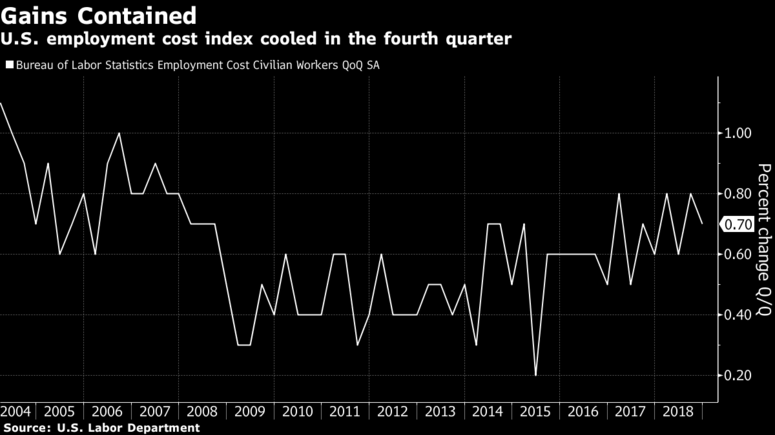 Wages and salaries for all civilian workers rose 3.1 percent from a year earlier, the most since 2008.
Wages and salaries for all civilian workers rose 3.1 percent from a year earlier, the most since 2008.
U.S. employment costs rose less than forecast in the fourth quarter as wage and salary gains cooled, adding to signs that inflation pressures remain mild despite a strong job market.
The employment cost index, a broad gauge monitored by the Federal Reserve, increased 0.7 percent in the October-December period from the prior quarter, according to Labor Department data released Thursday. That compared with the median estimate of economists for a 0.8 percent increase. Wages and salaries rose 0.6 percent following a 0.9 percent gain in the prior period.
Related: Power shift has cost wage earners $1.5 trillion since 2015 
Key insights:
- While employers are paying more and boosting benefits to retain workers as it becomes ever harder to hire, the data show little sign of a major pickup in compensation. Among private workers, the deceleration in the index over the quarter was more pronounced, with a 0.6 percent increase.
- At the same time, compensation costs have risen enough to help push the employment-cost index up 2.9 percent from a year earlier, the most since 2008.
- The lack of a big acceleration in labor costs reinforces the Fed's decision this week to indicate it will forgo interest-rate hikes for at least a while as various global risks mount. Policy makers on Wednesday cited “muted inflation pressures” as they shifted to a patient approach to future rate moves following four hikes in 2018.
- Growth in average hourly earnings, a separate monthly measure of private-sector wages that can be influenced by shifts in industry employment and hours worked, recently picked up above 3 percent for the first time since the economic expansion began.
- Wages and salaries for all civilian workers rose 3.1 percent from a year earlier, the most since 2008. For private workers, they were also up 3.1 percent from a year earlier, the same as the prior quarter.
- A separate Labor Department report on Thursday showed filings for unemployment benefits jumped last week to the highest since September 2017, possibly reflecting holiday- related swings and the partial government shutdown.
- The government's quarterly ECI reading covers employer-paid taxes such as Social Security and Medicare in addition to the cost of wages and benefits.
Read more:
© 2025 ALM Global, LLC, All Rights Reserved. Request academic re-use from www.copyright.com. All other uses, submit a request to [email protected]. For more information visit Asset & Logo Licensing.







